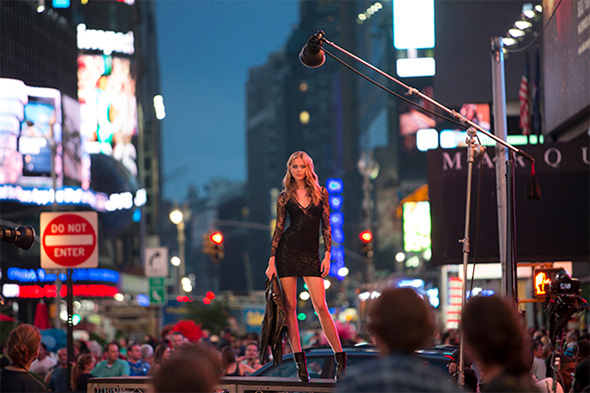New York Firm Will Support L.A. Post Customers from 30,000-Square-Foot Tribeca Facility
Earlier this month, digital photography services provider Industrial Color in New York City and post-production facility Modern VideoFilm in Burbank, CA, announced a partnership in which Industrial Color will provide on-set and in-house dailies services to Modern's customers in the New York area.
As Red Digital Cinema entered the camera market in the late 2000s, Industrial Color realized that the technological worlds of still photography and cinematography were starting to converge in important ways, with still cameras gaining video capabilities and some motion-picture cameras capable of producing nice stills. The result was that still photo shoots morphed into multifaceted productions that also created footage that could be used for social media, behind-the-scenes videos, broadcast advertising, and more. "Our hunch was pretty much on the money," Industrial Color CEO Steve Kalalian told StudioDaily. "On almost every photo shoot you see now, the photographer is also a director."
That meant that Industrial's infrastructure and staff, who had quickly gained experience with new camera formats including ARRI Alexa, Red, and Sony, were ready to support dailies customers. And Industrial's work with first-tier content owners like Turner, Warner Brothers, Sony and Showtime meant that it understood the importance of security. As Industrial looked to the future, a partnership with a West Coast post specialist seemed to make sense.
"Modern has incredible resources and 30 years in high-end post-production," Kalalian said. "But one of the things they don't have in New York City is the kind of facility we have. We can immediately turn on very high-end dailies support, primarily in New York, but also in other areas on the East Coast. And we have some of the same equipment — high-end Isilon servers, a 10-gigabit infrastucture. It was a perfect marriage."
One of the first dailies projects undertaken by Industrial was Undisputed Truth, a live-to-tape version of Mike Tyson's one-man stage show directed by Spike Lee and produced by HBO Films. Industrial Color managed color from the set, synced audio, and created LTO backups for all of the media that it ingested and processed — nearly 30 hours of material each of two nights — at its 30,000-square-foot facility in Tribeca, where color-review sessions with the director took place.
Industrial Color officials said the project was a good example of how its extensive experience in color management for still photography had prepared it to handle the same kind of work for high-end post-production clients. "It wasn't that it was a 13-week episodic show or a feature film, but there was a massive amount of footage, with 11 cameras running for two straight nights, generating something like 12 TB of data," Kalalian explained. "We ingested it, backed it up to tape, and then had ridiculous turnaround times in order to make it to edit the next day. It was a monster job, and great to work on together with Modern."

Other projects have tested Industrial's capability to think outside the box. "We had another project that was shot over several hours with eight Alexa cameras," said VP Todd Schweikert. "They built a runway and shut down Times Square for an Express campaign. We were there doing DIT work, setting up video billboards in Times Square as video monitors, feeding off the live camera. Our techs are very used to getting requests on demanding jobs and figuring out how to achieve them technically on everyone's schedule." Another recent project was the interactive "Deja View" web commercial for Infiniti, from Campfire NYC and Moschini Productions (Portland, OR), for which Industrial handled dailies.
Know-how becomes more important as the role of the DIT becomes more expansive. "A lot of communication has to take place [on set,] and the ACs, DPs, and directors are looking to the DIT for valuable feedback on color," Schweikert said. "These cameras are seeing more cross-platform utilization, and the DIT is in the middle of a lot of that information and data. Having the ability to understand video is key, but understanding politics and the technical aspects of photographic workflows goes even further."
And, no matter how much you learn, the jobs never get less demanding. "We just put in the latest Quantum LTO-6 storage unit, with 12 PB of capacity," Kalalian said. "It's amazing how quickly this stuff fills up. Even if you're established, you still need to invest a ton of money in infrastructure, equipment and storage. With formats changing all the time, things can get really messy. Digital hasn't necessarily made things easier. You need to have somebody you can trust, especially when one little software release can crater a production."
Looking forward, Kalalian sees transitions that changed the face of still photo shoots continuing to change the face of on-set color management and compositing work. "The conversation I'm seeing people in the video industry having is the same one we [in still photography] were having 10 years ago," he said. "You went from capturing on set and being done to capturing and processing and printing on set. And then you could retouch while you were on set. Some jobs do layouts on set. Finally, the studio or location becamse where 95 percent of the work is done.
"If you build a bridge, people will use it. On the motion side, our dailies kit has a full Resolve workstation in it. You can do color and compositing right there at the studio, so you're seeing a lot more post happening on location — maybe not final post, but certainly creative experimentation. We have a software entity called GLOBALedit, and we're releasing video markup capabilities on the iPad. So communication and review and approval and markup is all happening in real time. Who knows what's going to come next?"
Industrial Color: industrialcolor.com/